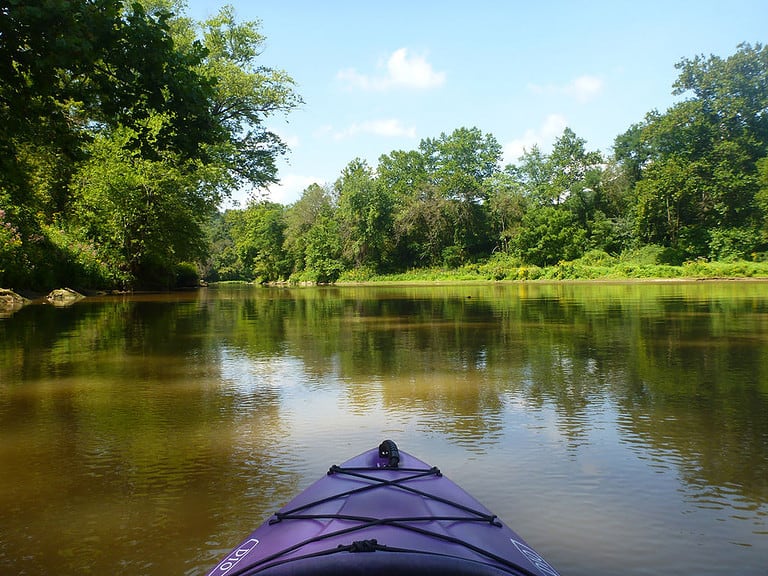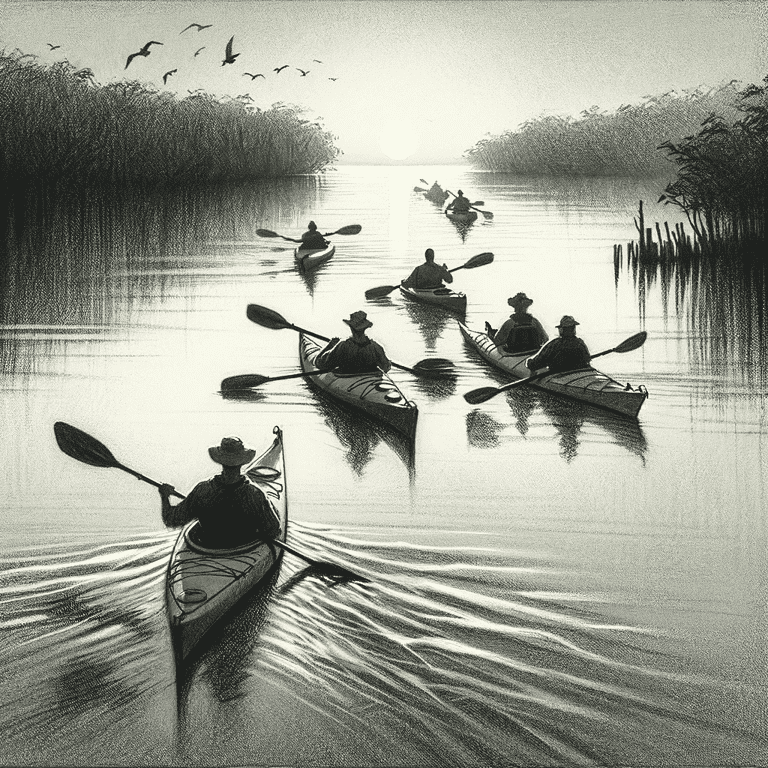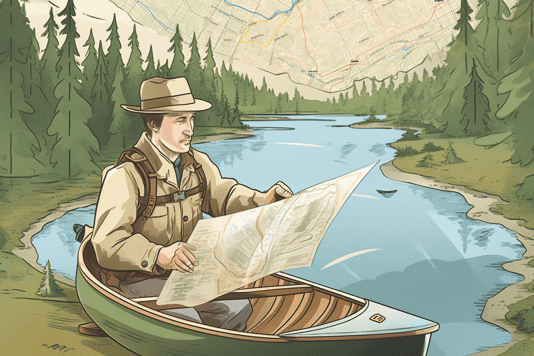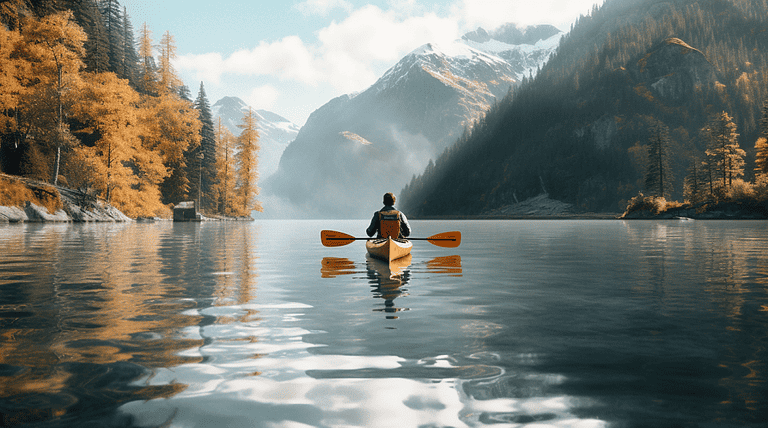Kayaking 101 For Beginners
Water has always held a captivating allure for me, beckoning with its sense of freedom and endless possibilities. Within the realm of water activities, kayaking stands out as an exhilarating pursuit that fully embodies both serenity and excitement.
Embarking on the journey of kayaking 101 for beginners may initially appear intimidating, as it encompasses a wealth of knowledge and equipment essentials. However, fear not, as I am here to serve as your trusted guide in this introductory kayaking expedition. Throughout this comprehensive article, we will delve into an array of invaluable topics: exploring the diverse range of kayaks at your disposal, discerning the ideal match for your personal preferences, acquiring essential gear to equip yourself before embarking on the water, mastering fundamental paddling techniques to propel you forward, and absorbing crucial safety measures to ensure an enjoyable experience. Prepare to immerse yourself in the wondrous realm of kayaking as we embark on this captivating journey together!
Water has always held a captivating allure for me, beckoning with its sense of freedom and endless possibilities. Within water activities, kayaking stands out as an exhilarating pursuit that fully embodies both serenity and excitement. Go Kayaking and enjoy the recreational kayak, but learn the basics tips for beginners.
Embarking on the kayaking journey may initially appear intimidating to beginners, as it encompasses a wealth of knowledge and equipment essentials. However, fear not, as I am here to serve as your trusted guide in this introductory kayaking expedition. Throughout this comprehensive article, we will delve into an array of invaluable topics: exploring the diverse range of kayaks at your disposal, discerning the ideal match for your personal preferences, acquiring essential gear to equip yourself before embarking on the water, mastering fundamental paddling techniques to propel you forward, and absorbing crucial safety measures to ensure an enjoyable experience. Prepare to immerse yourself in the wondrous realm of kayaking as we embark on this captivating journey together!
Key Takeaways
- Different kayaks are available, including sit-on-top, sit-inside, inflatable, and hard-shell kayaks.
- When choosing a kayak, it is important to consider the intended use, experience level, and budget.
- Essential kayaking and kayaking gear equipment includes a personal flotation device (PFD), a paddle, and proper kayak maintenance and storage practices.
- Safety tips such as checking the weather, staying close to shore, and always wearing a PFD are crucial for beginners.
Types of Kayaks
Let’s dive into the different types of kayaks that’ll make your heart race with excitement. There are two main types: sit on top and sit inside kayaks. Sit-on tops are perfect for beginners as they offer easy access, great stability, and a comfortable seating position. They’re also self-draining, so you won’t have to worry about getting waterlogged.
On the other hand, sit-inside kayaks offer better protection from the elements and are ideal for colder temperatures. They’re also faster and more maneuverable than their sit-on-top counterparts. However, they can be harder to get in and out of, especially if you’re not used to it.
Another factor to consider is whether you want an inflatable or hard shell kayak. Inflatable kayaks are incredibly portable and easy to store when deflated. They’re also durable and can handle rough waters without any issues. Hard shell kayaks are more traditional and provide better performance in speed and tracking.
Now that we’ve explored the different types of kayaks available, let’s choose the right one for you based on your needs and experience level.
Choosing the Right Kayak
Selecting the appropriate kayak requires careful consideration of several key factors: your intended use, experience level, and budget. These elements intertwine to shape the perfect kayaking experience tailored to your needs.
Size becomes a vital consideration when delving into the realm of kayak selection. The dimensions of your chosen vessel have a profound impact on its stability, speed, and maneuverability. Longer kayaks effortlessly glide through the water, granting you greater speed with minimal exertion. However, be prepared for a slight trade-off, as their elongated design can pose challenges when executing sharp turns. On the other hand, shorter kayaks provide nimble maneuverability, making navigation a breeze. Nevertheless, they demand a touch more energy to achieve higher speeds. A harmonious balance between these factors will ultimately guide you toward the perfect length for your aquatic endeavors. And let us not forget the importance of considering the weight capacity of your chosen kayak, allowing you to gauge its ability to accommodate both your own mass and any additional gear you intend to bring along on your voyage.
Material choices weave another layer of significance into the selection process. Plastic or polyethylene kayaks boast durability and affordability, making them a popular choice for many enthusiasts. However, it is worth noting that prolonged sun exposure may cause their vibrant hues to fade over time. Fiberglass kayaks emerge as a prime contender if speed and lightweight maneuverability are paramount to you. Though they possess a delicate nature and can succumb to brittleness when faced with rocky encounters, their ability to glide effortlessly through the water compensates for this vulnerability. For those seeking the pinnacle of durability and performance, carbon fiber kayaks reign supreme, albeit commanding a premium price for their cutting-edge qualities.
In the quest for your inaugural kayak, it’s crucial to remember that the perfect vessel transcends mere aesthetics or technical specifications. It is an amalgamation of your unique needs and preferences. Allow yourself the luxury of thorough research, exploring the diverse array of kayak types available, before making an informed purchase decision. In the upcoming section, I eagerly await the opportunity to divulge the essential equipment you must acquire to embrace the enchanting world of kayaking fully.
Selecting the appropriate kayak requires careful consideration of several key factors: your intended use, experience level, and budget. These elements intertwine to shape the perfect kayaking experience tailored to your needs.
Size becomes a vital consideration when delving into the realm of kayak selection. The dimensions of your chosen vessel have a profound impact on its stability, speed, and maneuverability. Longer kayaks effortlessly glide through the water, granting you greater speed with minimal exertion. However, be prepared for a slight trade-off, as their elongated design can pose challenges when executing sharp turns. On the other hand, shorter kayaks provide nimble maneuverability, making navigation a breeze. Nevertheless, they demand a touch more energy to achieve higher speeds. A harmonious balance between these factors will ultimately guide you toward the perfect length for your aquatic endeavors. And let us not forget the importance of considering the weight capacity of your chosen kayak, allowing you to gauge its ability to accommodate both your own mass and any additional gear you intend to bring along on your voyage.
Material choices weave another layer of significance into the selection process. Plastic or polyethylene kayaks boast durability and affordability, making them a popular choice for many enthusiasts. However, it is worth noting that prolonged sun exposure may cause their vibrant hues to fade over time. If speed and lightweight maneuverability hold paramount importance to you, fiberglass kayaks emerge as a prime contender. Though they possess a delicate nature and can succumb to brittleness when faced with rocky encounters, their ability to glide effortlessly through the water compensates for this vulnerability. For those seeking the pinnacle of durability and performance, carbon fiber kayaks reign supreme, albeit commanding a premium price for their cutting-edge qualities.
In the quest for your inaugural kayak, it’s crucial to remember that the perfect vessel transcends mere aesthetics or technical specifications. It is an amalgamation of your unique needs and preferences. Allow yourself the luxury of thorough research, exploring the diverse array of kayak types available, before making an informed purchase decision. In the upcoming section, I eagerly await the opportunity to divulge the essential equipment you must acquire to embrace the enchanting world of kayaking fully.
Essential Equipment
Embarking on a kayaking adventure is an exhilarating endeavor that necessitates the presence of essential gear to guarantee both your safety and enjoyment. Now, let’s embark on a comprehensive exploration of the indispensable equipment you should bring along on your aquatic escapades.
First and foremost, a personal flotation device (PFD) stands as an absolute must-have. This invaluable piece of gear keeps you buoyant in the event of an unexpected mishap and conserves your energy while propelling your kayak forward. Ensure that your chosen PFD fits snugly and comfortably, enveloping you in a secure embrace of protection. Remember, always wearing your PFD is paramount to a safe kayaking experience.
Another pivotal element in your kayaking arsenal is the paddle itself. Choosing the right paddle is key to maneuvering your kayak easily and precisely. Keep in mind that the paddle’s dimensions should align with your height and the width of your kayak. By adhering to this guideline, you will evade the struggle of wrestling with an ill-fitting paddle that hinders your mastery over the water. A helpful rule of thumb to determine the ideal paddle length is to hold it vertically, ensuring that your arms form a comfortable 90-degree angle at the elbow joint. Before embarking on aquatic expeditions, inspect your paddle for any damages or signs of wear, as a well-maintained paddle guarantees optimal performance and reliability.
Lastly, let us not underestimate the significance of proper kayak maintenance and storage practices. Ensuring the longevity and peak performance of your beloved vessel demands meticulous attention. After each thrilling trip, dedicate a moment to rinse off any saltwater or dirt that may have accumulated on your kayak. Regularly inspect the hull for potential cracks or dents, swiftly addressing any issues that may compromise the structural integrity of your kayak. When it comes to storage, find a dry area that shields your kayak from the harsh embrace of direct sunlight. This preventive measure shields your vessel from fading or warping, sparing you from the woes of costly repairs or unfortunate accidents on future excursions.
With the knowledge and appreciation of these essential gear components, your kayaking journey will soar to new heights of safety and fulfillment. Let us now venture forth without delay, immersing ourselves in basic paddling techniques in our upcoming section. Ensure you have a kayak paddle that fits your body type and the type of kayaking you will be doing. Kayaking is a great opportunity to enjoy the outdoors.
Embarking on a kayaking adventure is an exhilarating endeavor that necessitates the presence of essential gear to guarantee both your safety and enjoyment. Now, let’s embark on a comprehensive exploration of the indispensable equipment you should bring along on your aquatic escapades.
First and foremost, a personal flotation device (PFD) is an absolute must-have. This invaluable piece of gear keeps you buoyant in the event of an unexpected mishap and conserves your energy while propelling your kayak forward. Ensure that your chosen PFD fits snugly and comfortably, enveloping you in a secure embrace of protection. Remember, always wearing your PFD is paramount to a safe kayaking experience.
Another pivotal element in your kayaking arsenal is the paddle itself. Choosing the right paddle is critical to maneuvering your kayak quickly and precisely. Remember that the paddle’s dimensions should align with the height and width of your kayak. By adhering to this guideline, you will evade the struggle of wrestling with an ill-fitting paddle that hinders your mastery over the water. A helpful rule of thumb to determine the ideal paddle length is to hold it vertically, ensuring that your arms form a comfortable 90-degree angle at the elbow joint. Before embarking on aquatic expeditions, inspect your paddle for any damages or signs of wear, as a well-maintained paddle guarantees optimal performance and reliability.
Lastly, let us not underestimate the significance of proper kayak maintenance and storage practices. Ensuring the longevity and peak performance of your beloved vessel demands meticulous attention. After each thrilling trip, dedicate a moment to rinse off any saltwater or dirt that may have accumulated on your kayak. Regularly inspect the hull for potential cracks or dents, swiftly addressing any issues that may compromise the structural integrity of your kayak. When it comes to storage, find a dry area that shields your kayak from the harsh embrace of direct sunlight. This preventive measure shields your vessel from fading or warping, sparing you from the woes of costly repairs or unfortunate accidents on future excursions.
With the knowledge and appreciation of these essential gear components, your kayaking journey will soar to new heights of safety and fulfillment. Let us now venture forth without delay, immersing ourselves in the realm of basic paddling techniques in our upcoming section.
Basic Paddling Techniques
Embarking on a kayaking adventure opens a gateway to boundless thrills and unforgettable moments on the water. To ensure a safe and enjoyable experience, it becomes imperative to grasp the fundamentals of basic paddling techniques. Let us delve into a comprehensive exploration of these skills, equipping you with the knowledge to navigate the waters confidently.
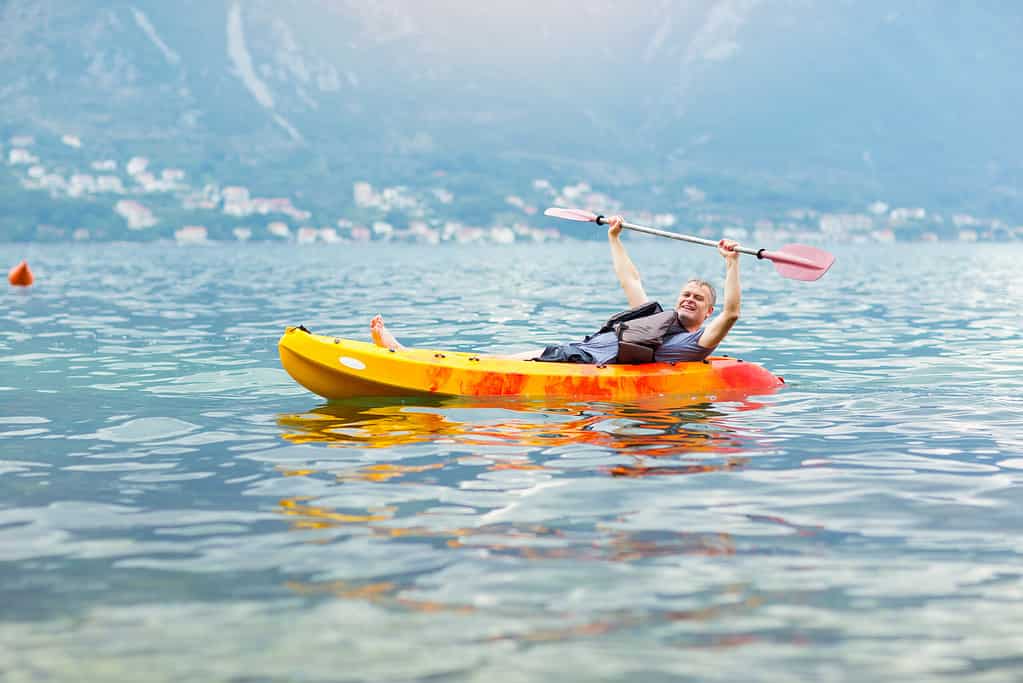
At the heart of every kayaker’s repertoire is mastery of the forward stroke—an art form that grants you the power and precision to propel your kayak forward gracefully. While the forward stroke manifests in various iterations, the key lies in maintaining a steady cadence, infusing each stroke with unwavering power. Allow your core muscles to engage as you elegantly rotate your torso harmoniously harmonizing with the rhythm of the water. Keeping your arms straight safeguards your shoulders from unnecessary strain, ensuring a sustainable and fluid motion through the vast expanse before you.
The ability to swiftly and efficiently turn your kayak becomes paramount in maneuverability. Behold the sweep stroke, an invaluable technique that facilitates quick changes in direction. With finesse and precision, initiate this stroke by sweeping your paddle blade in a wide arc from the side of your kayak, guiding it toward the stern or bow. Practice bestows you the grace to execute this maneuver seamlessly, enabling you to effortlessly navigate bends and curves without sacrificing momentum or stability. Alternatively, embrace the draw strokes—an alternative method to effectuate turns. Engage the water alongside your kayak, drawing it close to change your heading. These deliberate strokes bestow upon you the gift of directional control, granting you the freedom to explore new horizons.
As you master these foundational paddling techniques, a world of endless possibilities unfurls before you. Kayaking becomes an exhilarating symphony of movement and finesse. However, never allow complacency to overshadow the importance of safety. Embrace the wisdom of wearing a life jacket at all times, ensuring your well-being remains safeguarded amidst the wonders of the water. Prioritize checking weather conditions before venturing onto open waters, allowing you to navigate the elements with prudence and foresight. By regularly honing your skills and embracing safety precautions, the waters become your playground—a canvas upon which you paint unforgettable memories and traverse stunning bodies of water across the globe.
Armed with these extensive insights into kayaking, you are poised to embark on a journey brimming with discovery and pure delight. Immerse yourself in the symphony of strokes, the harmony of turns, and the thrill of the open water. The world awaits, ready to unveil its watery wonders. Now, let us delve deeper into the vast realm of kayaking adventures and unravel the secrets beyond the horizon.
Safety Tips
One should prioritize safety above all else when embarking on a kayaking expedition. The serenity of gliding through the water is best savored when accompanied by a sense of security and preparedness. Allow me to share a comprehensive guide to ensure your kayaking endeavors are enjoyable and free from unnecessary risks.
First and foremost, before setting foot in your kayak, take a moment to acquaint yourself with the weather forecast. Knowledge of the atmospheric conditions will serve as your compass, guiding you away from potential stormy situations. By heeding these meteorological insights, you can make informed decisions and choose the perfect time to immerse yourself in the tranquil embrace of the water.
To further enhance your safety, it is prudent to remain near the shore. While the allure of exploring the vast expanse of open waters beckons, it is vital to exercise caution and avoid venturing too far from the protective embrace of the shoreline. Staying within a comfortable distance allows for easy access to refuge in case unexpected circumstances arise. Remember, it is better to err on caution and prioritize proximity to land.
One non-negotiable element of kayaking safety is using a flotation device, commonly known as a personal flotation device (PFD). This invaluable piece of equipment is your faithful companion, a shield of protection in the face of unforeseen accidents or emergencies. Embrace the reassuring presence of your PFD, and wear kayaking to ensuring it is securely fastened and comfortably fits your body. Donning this essential gear grants you additional security, providing peace of mind throughout your kayaking expedition.
By embracing these simple yet vital safety measures, you cultivate an environment conducive to a harmonious blend of enjoyment and security. The water’s symphony becomes more vibrant, and each paddle stroke carries a sense of confidence. Remember, safety is not a burden but rather a liberating force that empowers you to explore the wonders of kayaking with tranquility and enthusiasm.
As you embark on your next kayaking adventure, let the knowledge of these safety practices be your guiding light. Immerse yourself in the serenity of the water, knowing that you have taken the necessary precautions to ensure a safe and memorable experience. Enjoy the beauty of nature, the rhythm of your paddling, and the freedom to embrace the joy of kayaking.
Check the Weather
Embarking on a thrilling kayaking adventure beckons, igniting a desire to navigate the tranquil waters with a sense of wonder and exhilaration. However, before you set sail on this aquatic odyssey, it is imperative to pay heed to the ever-changing skies and prepare for the unpredictable storms that life may conjure. Let me guide you through the essential practice of weather preparation, transforming your kayaking experience into a safe and enjoyable voyage.
Weather holds the key to unlocking the mysteries of the water. Its whimsical dance shapes the currents, dictates the wind’s direction, and influences the atmosphere that envelops you. To navigate these forces with poise and foresight, take a moment to study the patterns that weather presents. Delve into the understanding of wind, for it unravels the secrets of the current, revealing its strength and direction. Armed with this knowledge, you can chart your course wisely, avoiding any potential hazards and embracing the harmony of nature.
Making weather preparation an integral part of your pre-kayak routine ensures a voyage characterized by prudence and safety. Rely not solely on visual cues such as dark clouds or strong gusts, but rather seek the wisdom found within reliable sources of meteorological insight. Temperature, precipitation, wind speed—these invaluable tidbits of information shape the foundation of your preparation. Stay attuned to the forecasts, understanding that nature’s temperament can shift abruptly. In anticipation of unexpected situations, pack extra clothing and gear, for they become your armor against the capricious whims of the elements. Preparedness becomes your ally, enabling you to fully savor the wonders of the water while embracing a sense of security.
As you cast your gaze upon the vast expanse of water, let the wisdom of staying close to shore be your guiding star. Amidst the allure of exploration, proximity to land adds an extra layer of reassurance to your kayaking journey. Within the safety of the shoreline’s embrace, solace awaits should unforeseen circumstances arise. It serves as a bastion of security, a testament to your prudence and commitment to personal well-being. Remember, the freedom to roam does not overshadow the importance of proximity to safety.
Armed with the knowledge and practice of weather preparation, you embark upon your kayaking odyssey with a sense of anticipation and confidence. Let the water envelop you, and may each stroke of your paddle be a symphony of harmony. Cherish the beauty of nature, knowing that you have taken the necessary precautions to navigate its realm with wisdom and grace. As you immerse yourself in this watery wonderland, embrace the tranquility and thrill of kayaking, forging unforgettable memories along the way.
Kayaking 101 for beginners Stay Close to Shore
Embarking on the journey of kayaking as a beginner opens up a world of excitement and wonder. As you delve into this thrilling pursuit, it is crucial to prioritize safety to ensure that your time on the water is both enjoyable and secure. Let me guide you through a comprehensive exploration of essential practices that will pave the way for a fulfilling kayaking experience.
Checking the weather is a crucial first step for any kayaker, regardless of skill level. Understanding the atmospheric conditions empowers you to make informed decisions, safeguarding against potential hazards. Take a moment to consult reliable sources and grasp the forecast, assessing factors such as wind speed, precipitation, and temperature. Armed with this knowledge, you can adapt your plans accordingly, ensuring that each stroke of the paddle is embraced with a sense of prudence.
Once you have familiarized yourself with the weather conditions, maintaining proximity to the shore becomes an essential aspect of your kayaking journey. Staying close to land not only instills confidence and comfort within you but also acts as a protective shield against potential risks. As you navigate the waters, keep in mind some valuable navigation tips. Seek out landmarks such as majestic trees or prominent buildings that serve as reliable guideposts, leading you back to your launch point. Furthermore, be mindful of the direction of wind and currents, as they can influence your ability to paddle back towards the shore. Exercise caution, always erring on the side of prudence by staying closer rather than venturing too far out into unfamiliar territory.
As you weave your way through the gentle currents near the shoreline, be prepared for enchanting encounters with wildlife. Nature has a way of revealing its wonders, and you may find yourself captivated by the sight of vibrant birds soaring overhead, fish playfully leaping out of the water, or even the majestic presence of sea lions gracing your surroundings. However, it is crucial to approach these creatures with respect and appreciation from a safe distance. Remember, they are wild beings deserving of their space and tranquility. By observing from afar, you can relish these encounters while ensuring the preservation of their natural habitats.
In every kayaking adventure, the golden rule of safety must always prevail. We must never underestimate the importance of wearing personal flotation devices (PFDs). These indispensable companions serve as a lifeline, instilling a sense of security and buoyancy in case of any unforeseen incidents. Embrace the reassurance of your PFD, ensuring it is properly fitted and secured before setting off on your kayaking escapades.
Armed with these insights, you are ready to embark on a memorable kayaking experience. As you navigate the waters, guided by the wisdom of weather awareness, proximity to shore, and respect for wildlife, a world of enchantment and tranquility awaits. Allow the rhythm of your paddle strokes to harmonize with the ebb and flow of the water, savoring each moment with a sense of awe and gratitude. Now, it’s time to set sail and embark on your kayaking adventure, embracing the beauty of nature and the serenity of the water that surrounds you.
Always Wear Your PFD
Ensuring your safety while venturing into the vast expanse of the water is of paramount importance. Among the essential gear that accompanies you on your kayaking expeditions, the Personal Flotation Device (PFD) stands as an unwavering guardian, promising to keep you afloat in times of need. Allow me to guide you through the intricacies of choosing and fitting your PFD, equipping you with the knowledge to navigate the waters with confidence and peace of mind.
Before donning your PFD, it is crucial to verify its compliance with the rigorous safety standards set forth by the Coast Guard. Take a moment to examine the label, ensuring that the PFD you choose meets the prescribed regulations for buoyancy and safety. This diligent scrutiny guarantees that you possess a device that can truly be relied upon in times of unforeseen circumstances.
Once you have acquired a PFD that meets the necessary standards, the next step is achieving a proper fit. Embrace the importance of comfort without compromising on security. Your PFD should snugly embrace your body, offering a reassuring sense of containment. Strive for a fit that is neither too tight nor uncomfortably constricting. Take the time to adjust the straps, fine-tuning the fit until you achieve a balance of both comfort and reliability. Remember, your PFD is an ally that should empower you, never hindering your mobility or impeding your enjoyment of the kayaking experience.
In the realm of safety, vigilance should always prevail. Regardless of your swimming prowess or the tranquility of the waters around you, the presence of your PFD is non-negotiable. Accidents can occur unexpectedly, and it is through unwavering preparedness that we safeguard ourselves. By donning your PFD at all times during your kayaking adventures, you create a shield of protection that offers both solace and reassurance.
As you embark on your kayaking journey, remember that your PFD is more than a mere piece of equipment—it is a lifeline. It bestows upon you the freedom to revel in the beauty of nature while embracing a sense of security. By following these simple tips for fitting and wearing your PFD correctly, you fortify your safety measures and embrace the joy of kayaking with peace of mind. The waters await, and with your trusted PFD by your side, you are ready to embark on unforgettable adventures while remaining firmly grounded in a cocoon of safety.
Frequently Asked Questions
Is it necessary to have prior swimming experience before kayaking?
No prior swimming experience is necessary for kayaking, but it is a beneficial skill to have. Kayaking provides numerous physical and mental benefits, and common mistakes can be avoided by taking lessons. Remember: “You never know until you try.”
Can kayaking be done alone or is it better to go with a group?
Kayaking can be done alone, but it’s safer to go with a group. If you choose to kayak solo, make sure you take safety precautions such as wearing a life jacket and letting someone know your itinerary.
How do I know if the water conditions are safe for kayaking?
Before kayaking, I always check the water conditions for safety. I use a “red sky at night, sailor’s delight”approach to evaluate weather patterns. Additionally, I bring appropriate safety measures like a life jacket and whistle.
What should I do if my kayak capsizes?
If my kayak capsizes, I stay calm and assess the situation. Then, I use the recovering technique to flip it over and climb back in. Proper equipment preparation beforehand can make this process easier.
Is it necessary to have a license or certification to kayak?
Did you know that in the US, kayaking is responsible for only 0.5% of all boating fatalities? While a kayaking license or certification isn’t required, it’s important to educate yourself and stay safe on the water.
Conclusion
Well, that’s it for my kayaking 101 guide for beginners. I hope you found this article informative and helpful in your journey to becoming a successful kayaker.
As I mentioned earlier, kayaking can be a great way to explore the outdoors and stay active. However, safety should always be your top priority. Remember to always wear a life jacket, check the weather and water conditions before heading out, and let someone know where you’re going.
One real-life example of why safety is important happened to me last summer. I was out on the water with some friends when suddenly a storm rolled in without warning. The wind picked up and waves started crashing into our kayaks. Thanks to our preparedness, we were able to safely make it back to shore before things got too dangerous.
So remember, have fun but always prioritize safety when kayaking!


